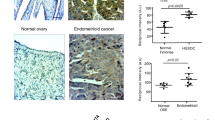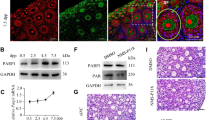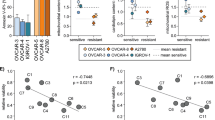Abstract
Female ovaries degenerate about 20 years earlier than testes leading to reduced primordial follicle reserve and a reduction in oocyte quality. Here we found that bridge integrator 2 (BIN2) is enriched in mouse ovaries and oocytes and that global knockout of this protein improves both female fertility and oocyte quality. Quantitative ovarian proteomics and phosphoproteomics showed that Bin2 knockout led to a decrease in phosphorylated ribosomal protein S6 (p-RPS6), a component of the mammalian target of rapamycin pathway and greatly increased nicotinamide nucleotide transhydrogenase (NNT), the free-radical detoxifier. Mechanistically, we find that phosphorylation of BIN2 at Thr423 and Ser424 leads to its translocation from the membrane to the cytoplasm, subsequent phosphorylation of RPS6 and inhibition of Nnt translation. We synthesized a BIN2-penetrating peptide (BPP) designed to inhibit BIN2 phosphorylation and found that a 3-week BPP treatment improved primordial follicle reserve and oocyte quality in aging and after chemotherapy-induced premature ovarian failure without discernible side effects.
This is a preview of subscription content, access via your institution
Access options
Access Nature and 54 other Nature Portfolio journals
Get Nature+, our best-value online-access subscription
$29.99 / 30 days
cancel any time
Subscribe to this journal
Receive 12 digital issues and online access to articles
$119.00 per year
only $9.92 per issue
Buy this article
- Purchase on Springer Link
- Instant access to full article PDF
Prices may be subject to local taxes which are calculated during checkout








Similar content being viewed by others
Data availability
The data that support the findings of this study are available from the corresponding author upon reasonable request. Supplementary Datasets 1–5 have been deposited into Zenodo (https://doi.org/10.5281/zenodo.4006605). Raw data and extracted text files for quantitative proteomics and phosphoproteomics have been deposited into PRIDE, under accession nos. PXD028776 and PXD028777, respectively.
References
Laisk, T. et al. Demographic and evolutionary trends in ovarian function and aging. Hum. Reprod. Update 25, 34–50 (2019).
McCracken, K. & Nahata, L. Fertility preservation in children and adolescents: current options and considerations. Curr. Opin. Obstet. Gynecol. 29, 283–288 (2017).
Lawrenz, B. et al. Fertility preservation in girls and adolescents before chemotherapy and radiation - review of the literature. Klin. Padiatr. 223, 126–130 (2011).
Spears, N. et al. Ovarian damage from chemotherapy and current approaches to its protection. Hum. Reprod. Update 25, 673–693 (2019).
Chang, H. M., Wu, H. C., Sun, Z. G., Lian, F. & Leung, P. C. K. Neurotrophins and glial cell line-derived neurotrophic factor in the ovary: physiological and pathophysiological implications. Hum. Reprod. Update 25, 224–242 (2019).
Liu, Y. et al. The BMP4-Smad signaling pathway regulates hyperandrogenism development in a female mouse model. J. Biol. Chem. 292, 11740–11750 (2017).
Saatcioglu, H. D., Cuevas, I. & Castrillon, D. H. Control of oocyte reawakening by kit. PLoS Genet. 12, e1006215 (2016).
Baumgarten, S. C., Armouti, M., Ko, C. & Stocco, C. IGF1R expression in ovarian granulosa cells is essential for steroidogenesis, follicle survival, and fertility in female mice. Endocrinology 158, 2309–2318 (2017).
Chen, J. et al. Somatic cells regulate maternal mRNA translation and developmental competence of mouse oocytes. Nat. Cell Biol. 15, 1415–1423 (2013).
De Felici, M., Lobascio, A. M. & Klinger, F. G. Cell death in fetal oocytes: many players for multiple pathways. Autophagy 4, 240–242 (2008).
Guo, J. et al. Oocyte stage-specific effects of MTOR determine granulosa cell fate and oocyte quality in mice. Proc. Natl Acad. Sci. USA 115, E5326–E5333 (2018).
Guo, J. et al. Oocyte-dependent activation of MTOR in cumulus cells controls the development and survival of cumulus–oocyte complexes. J. Cell Sci. 129, 3091–3103 (2016).
Yang, W. L. et al. A reduction of cyclooxygenase 2 gene dosage counters the ovarian morphological aging and tumor phenotype in Wv mice. Am. J. Pathol. 170, 1325–1336 (2007).
Zhou, X. L. et al. SIRT1 activator (SRT1720) improves the follicle reserve and prolongs the ovarian lifespan of diet-induced obesity in female mice via activating SIRT1 and suppressing mTOR signaling. J. Ovarian Res. 7, 97 (2014).
Dou, X. et al. Short-term rapamycin treatment increases ovarian lifespan in young and middle-aged female mice. Aging Cell 16, 825–836 (2017).
Li, L. et al. Caloric restriction promotes the reserve of follicle pool in adult female rats by inhibiting the activation of mammalian target of rapamycin signaling. Reprod. Sci. 22, 60–67 (2015).
Goldman, K. N. et al. mTORC1/2 inhibition preserves ovarian function and fertility during genotoxic chemotherapy. Proc. Natl Acad. Sci. USA 114, 3186–3191 (2017).
Blagden, S. et al. First-in-human study of CH5132799, an oral class I PI3K inhibitor, studying toxicity, pharmacokinetics, and pharmacodynamics, in patients with metastatic cancer. Clin. Cancer Res. 20, 5908–5917 (2014).
Ding, C. et al. HGF and BFGF secretion by human adipose-derived stem cells improves ovarian function during natural aging via activation of the SIRT1/FOXO1 signaling pathway. Cell. Physiol. Biochem. 45, 1316–1332 (2018).
Cong, Y. et al. Ptk2b deletion improves mice folliculogenesis and fecundity via inhibiting follicle loss mediated by Erk pathway. J. Cell Physiol. https://doi.org/10.1002/jcp.29914 (2020).
Wang, Y. et al. Human adipose-derived mesenchymal stem cell-secreted CXCL1 and CXCL8 facilitate breast tumor growth by promoting angiogenesis. Stem Cells 35, 2060–2070 (2017).
Rodriguez-Aguayo, C. et al. PTGER3 induces ovary tumorigenesis and confers resistance to cisplatin therapy through up-regulation Ras-MAPK/Erk-ETS1-ELK1/CFTR1 axis. eBioMedicine 40, 290–304 (2019).
Kala, M., Shaikh, M. V. & Nivsarkar, M. Equilibrium between anti-oxidants and reactive oxygen species: a requisite for oocyte development and maturation. Reprod. Med. Biol. 16, 28–35 (2016).
Singh, A. K., Chattopadhyay, R., Chakravarty, B. & Chaudhury, K. Markers of oxidative stress in follicular fluid of women with endometriosis and tubal infertility undergoing IVF. Reprod. Toxicol. 42, 116–124 (2013).
Miao, Y., Cui, Z., Gao, Q., Rui, R. & Xiong, B. Nicotinamide mononucleotide supplementation reverses the declining quality of maternally aged oocytes. Cell Rep. 32, 107987 (2020).
Bertoldo, M. J. et al. NAD+ repletion rescues female fertility during reproductive aging. Cell Rep. 30, 1670–1681 (2020).
Boots, C. E., Boudoures, A., Zhang, W., Drury, A. & Moley, K. H. Obesity-induced oocyte mitochondrial defects are partially prevented and rescued by supplementation with co-enzyme Q10 in a mouse model. Hum. Reprod. 31, 2090–2097 (2016).
Chen, L. J. et al. Single xenotransplant of rat brown adipose tissue prolonged the ovarian lifespan of aging mice by improving follicle survival. Aging Cell 18, e13024 (2019).
Jang, H. et al. Melatonin prevents cisplatin-induced primordial follicle loss via suppression of PTEN/AKT/FOXO3a pathway activation in the mouse ovary. J. Pineal Res. 60, 336–347 (2016).
Naseer, Z. et al. Quercetin supplemented diet improves follicular development, oocyte quality, and reduces ovarian apoptosis in rabbits during summer heat stress. Theriogenology 96, 136–141 (2017).
Liu, M. et al. Resveratrol protects against age-associated infertility in mice. Hum. Reprod. 28, 707–717 (2013).
Shi, L., Li, N., Bo, L. & Xu, Z. Melatonin and hypothalamic–pituitary–gonadal axis. Curr. Med. Chem. 20, 2017–2031 (2013).
Resende, F. A., Vilegas, W., Dos Santos, L. C. & Varanda, E. A. Mutagenicity of flavonoids assayed by bacterial reverse mutation (Ames) test. Molecules 17, 5255–5268 (2012).
Reddy, P. et al. Oocyte-specific deletion of Pten causes premature activation of the primordial follicle pool. Science 319, 611–613 (2008).
Ho, H. Y., Lin, Y. T., Lin, G., Wu, P. R. & Cheng, M. L. Nicotinamide nucleotide transhydrogenase (NNT) deficiency dysregulates mitochondrial retrograde signaling and impedes proliferation. Redox Biol. 12, 916–928 (2017).
Zhao, H. et al. Single-cell transcriptomics of human oocytes: environment-driven metabolic competition and compensatory mechanisms during oocyte maturation. Antioxid. Redox Signal. 30, 542–559 (2019).
Dutta, S. & Sengupta, P. Men and mice: relating their ages. Life Sci. 152, 244–248 (2016).
Morris, M. C., Depollier, J., Mery, J., Heitz, F. & Divita, G. A peptide carrier for the delivery of biologically active proteins into mammalian cells. Nat. Biotechnol. 19, 1173–1176 (2001).
Rao, Y. & Haucke, V. Membrane shaping by the Bin/amphiphysin/Rvs (BAR) domain protein superfamily. Cell. Mol. Life Sci. 68, 3983–3993 (2011).
Kessels, M. M. & Qualmann, B. Different functional modes of BAR domain proteins in formation and plasticity of mammalian postsynapses. J. Cell Sci. 128, 3177–3185 (2015).
Sánchez-Barrena, M. J. et al. Bin2 is a membrane sculpting N-BAR protein that influences leucocyte podosomes, motility and phagocytosis. PLoS ONE 7, e52401 (2012).
Volz, J. et al. BIN2 orchestrates platelet calcium signaling in thrombosis and thrombo-inflammation. J. Clin. Invest. 130, 6064–6079 (2020).
Meyuhas, O. Ribosomal protein S6 phosphorylation: four decades of research. Int. Rev. Cell Mol. Biol. 320, 41–73 (2015).
Hutchinson, J. A., Shanware, N. P., Chang, H. & Tibbetts, R. S. Regulation of ribosomal protein S6 phosphorylation by casein kinase 1 and protein phosphatase 1. J. Biol. Chem. 286, 8688–8696 (2011).
Ang, Z. et al. Novel AU-rich proximal UTR sequences (APS) enhance CXCL8 synthesis upon the induction of rpS6 phosphorylation. PLoS Genet. 15, e1008077 (2019).
Reddy, P. et al. PDK1 signaling in oocytes controls reproductive aging and lifespan by manipulating the survival of PMFs. Hum. Mol. Genet. 18, 2813–2824 (2009).
Vozenilek, A. E. et al. Absence of nicotinamide nucleotide transhydrogenase in C57BL/6J mice exacerbates experimental atherosclerosis. J. Vasc. Res. 55, 98–110 (2018).
Son, M. J., Kwon, Y., Son, T. & Cho, Y. S. Restoration of mitochondrial NAD(+) levels delays stem cell senescence and facilitates reprogramming of aged somatic cells. Stem Cells 34, 2840–2851 (2016).
Acknowledgements
This work was financially supported by the National Key Research and Development Program of China (grant nos. 2018YFC1003400 and 2017YFC1001503 to D.Z. and 2018YFA0107701 to Q.-Y.S.), the Youth Innovation Promotion Association CAS (grant no. 2017114) to Z.-B.W. and National Natural Science Foundation of China (grant nos. 32070840 to D.Z. and 31871504 to Q.-Y.S.). Funding for data collection and analysis was from grant nos. 2018YFC1003400, 2017YFC1001503, 2018YFA0107701 and 32070840; and funding for conceptualization, design, decision to publish and preparation of the manuscript was from grant nos. 2018YFC1003400, 2017YFC1001503, 2018YFA0107701, 2017114, 32070840 and 31871504.
Author information
Authors and Affiliations
Contributions
D.Z., Q.-Y.S. and Z.-B.W. designed the research. T.-G.M. developed the Bin2-KO mice under the direction of Q.-Y.S. and Z.-B.W.; F.-Y.Z., L.-L.W. and R.-L.W. performed most of the experiments. Z.-X.Y. coordinated between authors. Y.C. assisted during the experiments. G.-Y.Z., Z.J., L.-L.G. and W.-T.Z. conducted preliminary studies of BIN2. F.-Y.Z. and L.-L.W. conducted all data analysis and prepared figures under the direction of D.Z., Q.-Y.S. and Z.-B.W. D.Z. and Z.-X.Y. wrote the manuscript. Q.-Y.S. and Z.-B.W. proofread the manuscript and gave advice.
Corresponding authors
Ethics declarations
Competing interests
The authors declare no competing interests.
Additional information
Peer review information Nature Aging thanks Karen Schindler and the other, anonymous, reviewer(s) for their contribution to the peer review of this work.
Publisher’s note Springer Nature remains neutral with regard to jurisdictional claims in published maps and institutional affiliations.
Supplementary information
Supplementary Information
Legends for Supplementary Figs. 1–10; legends for Supplementary Datasets 1–5; Supplementary Tables 1–7 and unprocessed blot images for Supplementary Fig. 2.
Supplementary Data 1
Related to all fertility assays. WT mating male mice were rotated on a monthly basis between cages according to this random allocation table.
Supplementary Data 2
Related to Fig. 2a–c. This Excel file contains three sheets: the ‘All identified phospho sites’ sheet includes all site-phosphorylation values and related identified information from two repeats of WT and Bin2-KO PND-21 ovaries. The ‘Bin2-KO vs WT ≥ 1.2 up’ sheet includes all differential site-phosphorylation values and related information with 1.2-fold upregulation. The ‘Bin2-KO vs WT ≤ 0.83 down’ sheet includes all differential site-phosphorylation values and related information with 0.83-fold downregulation.
Supplementary Data 3
Related to Figs. 2g and 5a,b. This Excel file contains three sheets: the ‘All identified proteins’ sheet includes all protein expression values and related identified information from two repeats of WT and Bin2-KO PND-21 ovaries. The ‘Bin2-KO vs WT ≥ 1.2 up’ sheet includes all differentially expressed protein (DEP) values and related information with 1.2-fold upregulation. The ‘Bin2-KO vs WT ≤ 0.83 down’ sheet includes all DEP values and related information with 0.83-fold downregulation.
Supplementary Data 4
Related to Fig. 2h. This Excel file contains one sheet: ‘All gene expression-FPKM & log2’ includes FPKM and log2 values of all identified genes and related information from three repeats of PND-21 WT and Bin2-KO mouse ovaries. To avoid the illegal calculation of value ‘0,’ we added a minimal value ‘0.001’ to all original values (and verified that this did not alter any differential trends).
Supplementary Data 5
Related to Fig. 6n–p. This Excel file contains four sheets: The ‘All gene expression-FPKM & log2’ sheet includes FPKM and log2 values for all identified genes and related information from three repeats of the 2-month (2 M), 9-month (9 M) and 9-month + BPP (9M-BPP) groups. The ‘|log2(Ave-2M)vs(Ave-9M)|≥2’ sheet includes all genes and related information with twofold differential expression between the 2 M and 9 M groups. The ‘|log2(Ave-9M-BPP)vs(Ave-9M)|≥2’ sheet includes all genes and related information with twofold differential expression between the 9M-BPP and 9 M groups. The ‘2Mvs9M-BPPvs9M overlap’ includes all genes and related information that overlapped between ‘|log2(Ave-2M)vs(Ave-9M)|≥2’ and ‘|log2(Ave-9M-BPP)vs(Ave-9M)|≥2’. To avoid the illegal calculation of value ‘0,’ we added a minimal value ‘0.001’ to all original values (and verified that this did not alter any differential trends).
Source data
Source Data Fig. 1
Unprocessed western blots and/or gels.
Source Data Fig. 2
Unprocessed western blots and/or gels.
Source Data Fig. 3
Unprocessed western blots and/or gels.
Source Data Fig. 4
Unprocessed western blots and/or gels.
Source Data Fig. 5
Unprocessed western blots and/or gels.
Source Data Fig. 6
Unprocessed western blots and/or gels.
Source Data Fig. 7
Unprocessed western blots and/or gels.
Source Data Fig. 8
Unprocessed western blots and/or gels.
Rights and permissions
About this article
Cite this article
Zhu, FY., Wang, LL., Meng, TG. et al. Inhibiting bridge integrator 2 phosphorylation leads to improved oocyte quality, ovarian health and fertility in aging and after chemotherapy in mice. Nat Aging 1, 1010–1023 (2021). https://doi.org/10.1038/s43587-021-00133-4
Received:
Accepted:
Published:
Issue Date:
DOI: https://doi.org/10.1038/s43587-021-00133-4
This article is cited by
-
HucMSC-EVs Facilitate In Vitro Development of Maternally Aged Preantral Follicles and Oocytes
Stem Cell Reviews and Reports (2023)
-
Inhibition of BIN2 extends reproductive lifespan
Nature Aging (2021)



